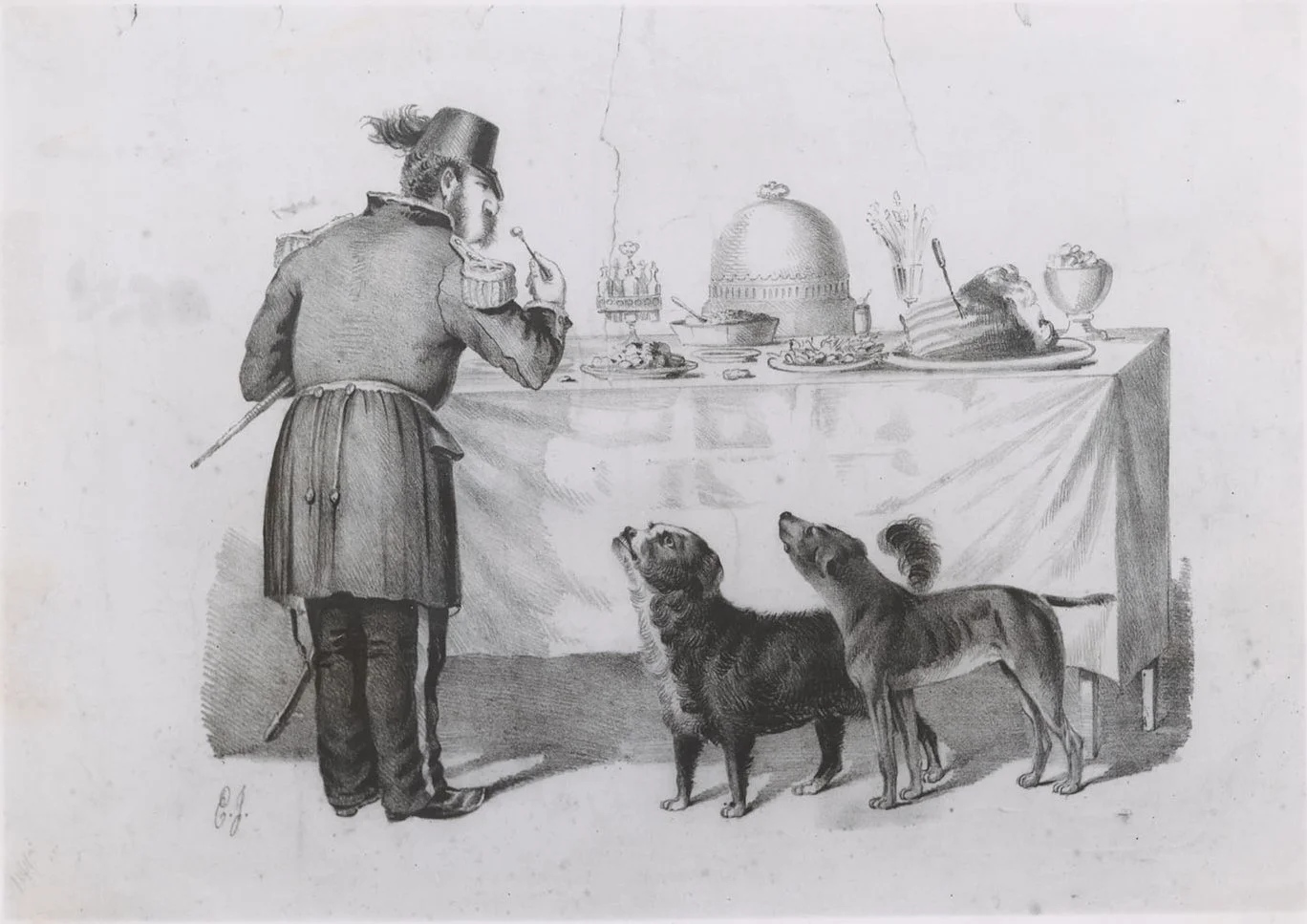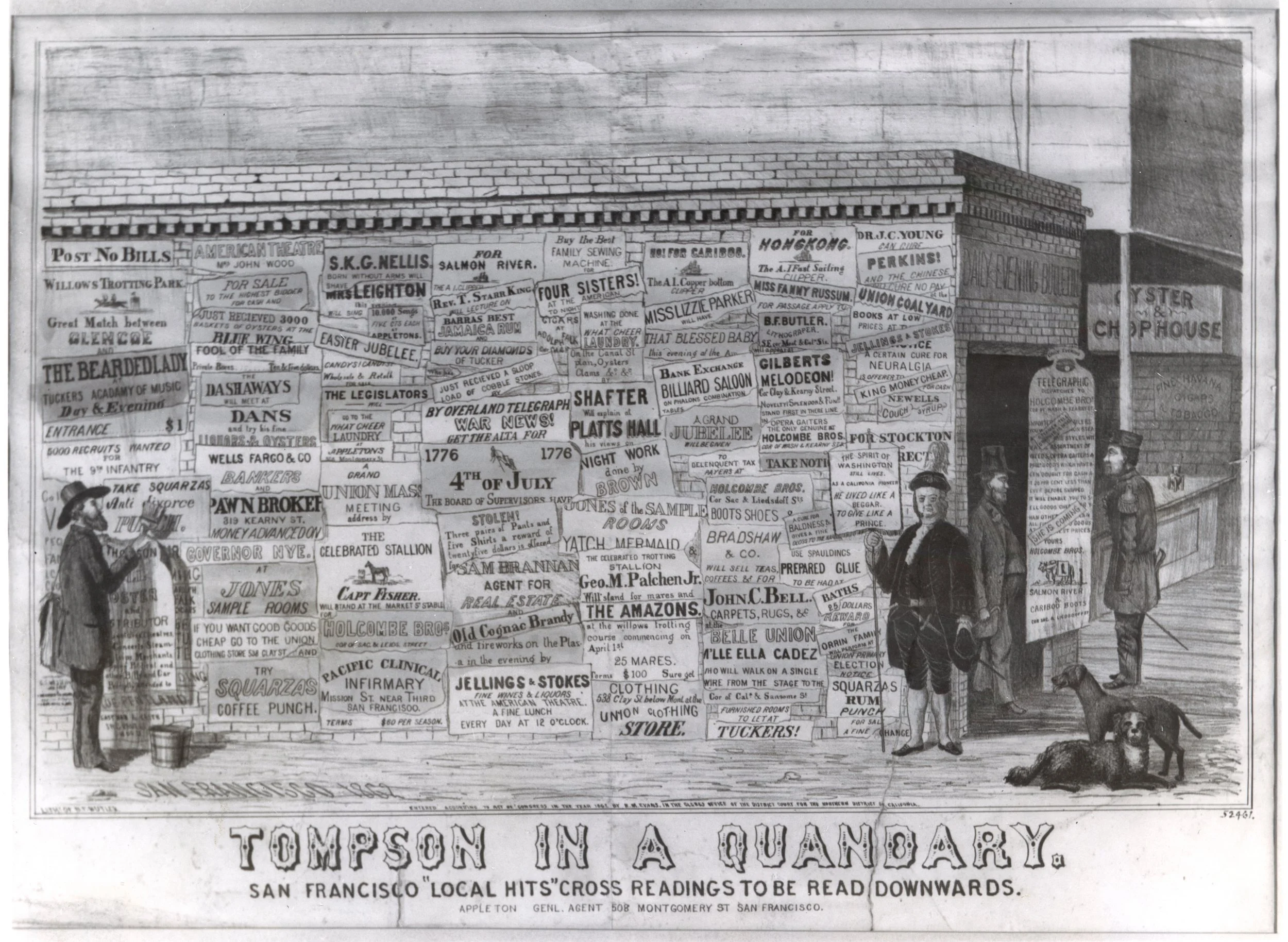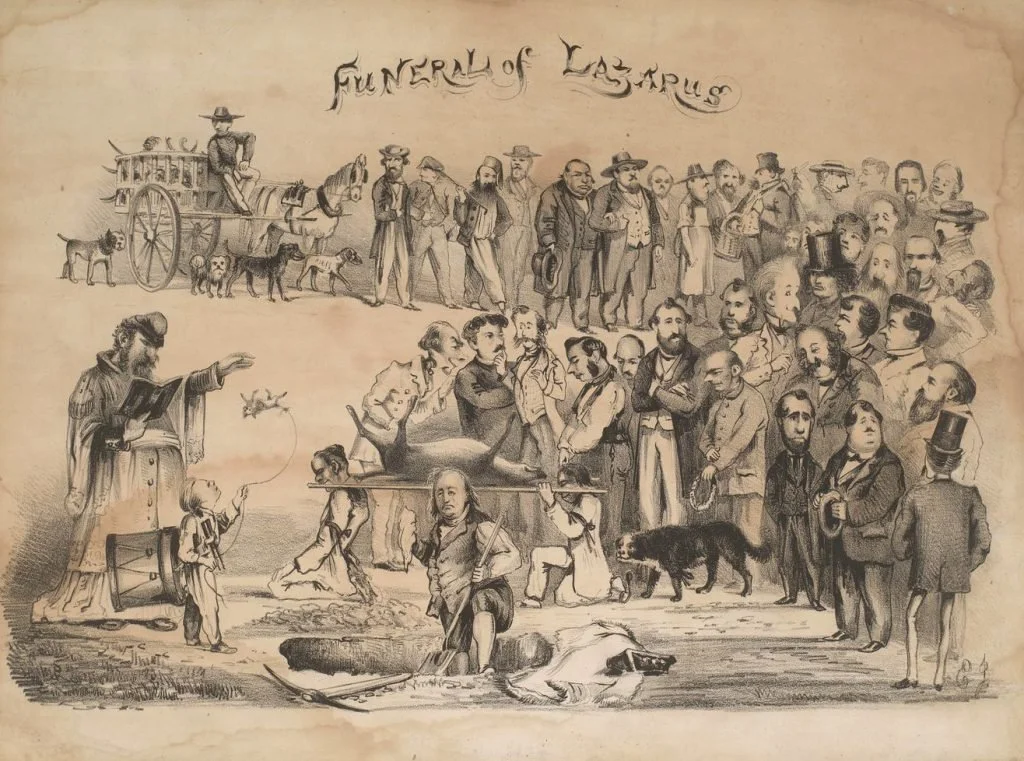The Emperor Norton Cartoon That Got the Jump on Jump
In the Early 1860s, the Artist Edward Jump Created Three Cartoons That Associated Emperor Norton with the Dogs Bummer & Lazarus.
Jump Was Not the First Artist to Make the Connection.
THE URBAN LEGEND that Bummer and Lazarus were “Emperor Norton’s dogs” probably got its biggest boost from at least three comic illustrations created by the caricaturist Edward Jump (1832–1883) while Jump was living in San Francisco in the 1860s.
The best-known of these cartoons, dated February 1863, shows a view of the Emperor eating at a free-lunch table, with Bummer and Lazarus looking up at him longingly from below.
Cartoon of a free-lunch scene with Emperor Norton and the dogs Bummer and Lazarus, February 1863. By Edward Jump (1832–1883). Collection of the Bancroft Library, UC Berkeley. Source: Berkeley Library Digital Collections
In 2016, when The Emperor Norton Trust launched its digital ARchive of Emperor Norton in Art, Music & Film (ARENA), the Jump cartoon featuring the Emperor and the dogs that had the earliest date attached to it was this Montgomery Street scene:
Cartoon of Montgomery Street scene featuring Emperor Norton; Bummer and Lazarus; and George Washington II (later titled “Stock Brokers; And Still They Are Marching On”), 1863 (possibly between February and October 1863). By Edward Jump (1832–1883). Collection of the Bancroft Library, UC Berkeley. Source: Online Archive of California
None of the extant public images of this cartoon shows a title on the cartoon itself. So, we adopted “Stock Brokers; And Still They Are Marching On,” a version of the title used by the Bancroft Library at UC Berkeley.
Sources for “Stock Brokers” were split between 1861 and 1863. So, we dated the cartoon “c.1861–63” — recognizing that a confirmed 1861 date of authorship would make this the earliest Emperor Norton cartoon and the earliest cartoon featuring the Emp and Bummer & Lazarus in the same scene.
BUT…
I was aware of a cartoon potentially answering to this description that — at the very least — was older than 1863. I'd seen a thumbnail of it on the de Young Museum website in the earliest years of the Trust.
The cartoon — inscribed "San Francisco 1862" at the bottom and dated 1862 in catalog records — is titled “Tompson in a Quandary.”
“Tompson in a Quandary,” 1861 or 1862 (possibly between September 1861 and September 1862). By R.M. Evans. Lithograph by Benjamin Franklin Butler (1819–1865). As to the scale of the original: While the image above is reproduced from an unidentified print source, the Fine Arts Museums of San Francisco has an original lithograph of the work that is catalogued as being 48.4 cm x 30.2 cm. Collection of the Bancroft Library, UC Berkeley. Source: Berkeley Library Digital Collections
The de Young Museum and the Bancroft Library — the only other institution I’ve found to have this work in its collection — credit this cartoon to its lithographer, Benjamin Franklin Butler (1819–1865) — not to be confused with the Civil War general and politician of the same name and overlapping dates (1818–1893).
The inscription “Lith. of B.F. Butler” does appear at the bottom left of the cartoon. But, the fine print just above the title reads: “Entered According to Act of Congress in the Year 1862 [?] by R.M. Evans, In the Clerks Office of the District Court for the Northern District of California.”
This strongly suggests that the cartoon is not by Butler — but that it is by R.M. Evans. By profession, Evans was a mining surveyor and cartographer, not an artist. But, as a business matter, mapmakers and lithographers needed one another — so, it’s not a stretch to think that Evans and Butler swam in the same waters.
Details for R.M. Evans are scarce — but, there is a snippet of a trail.
Evans — assuming it is our Evans — is listed as a passenger on the Pacific Mail steamship John L. Stephens arriving in San Francisco from New York on 16 October 1858 (left column, a third the way down, in the attached list):
The first San Francisco directory listing for Evans, in Langley’s directory for 1860, finds him listed as a “surveyor” at 59 Montgomery Block. Evans drops out of the 1861 directory but is back in 1862 — listed as Commissioner of Deeds for the Nevada Territory, living at the northeast corner of Sansome and California Streets.
It’s notable that the same directory, 1862, lists Emperor Norton living just two blocks to the south, at the Metropolitan Hotel, on the southwest corner of Sansome and Bush.
In 1860, Britton & Co. lithographed and published The only correct and reliable Map of the Washoe Mining Region, anchored by Carson City, which then was part of the Utah Territory. The map was “Designed and drawn by R.M. Evans.” It appears that, over the course of a couple of years, this map was published both on its own and together with a broadside titled Evans’ Travellers’ Guide. [See caption below for links to the full map and a view of the broadside cover.]
Title detail from The only correct and reliable Map of the Washoe Mining Region, R.M. Evans, 1860. Lithographed and published by Britton & Co.* Collections: Beinecke Rare Book and Manuscript Library, Yale University; Huntington Library. Source: Beinecke (full map); Huntington (cover of companion Evans’ Travellers’ Guide)
* Joseph Britton is well known as the lead partner in Britton & Rey (1852–59) and Britton, Rey & Co. (1866–92). But, from 1859 to 1866, Britton headed the lithographic firm of J.W. Britton & Co. with partners Henry Steinegger and Xavier Van de Casteele.
During the 1860–61 period, when R.M. Evans was exploring and surveying the Washoe region, the San Francisco Daily Evening Bulletin and Daily Alta California newspapers published occasional letters from Evans in which he documented the region’s landscape, economic development, culture, and politics.
It appears that “Tompson in a Quandary” is the only extant cartoon by R.M. Evans. This invites the conclusion that Evans created “Tompson” as a lark or that, at most — for Evans — comic illustration never rose above the level of an avocation.
At least one later source, Joseph Armstrong Baird’s Historic Lithographs of San Francisco (1982), transcribes Evans’s registration info as “1861.” I think there’s enough visual ambiguity in the fine print to see it as “1861” or “1862.”
But, even an 1862 date for Evans’s cartoon could be enough to make it the earliest artistic work putting Emperor Norton and the dogs Bummer and Lazarus “in the same room.”
:: :: ::
BEFORE GOING DEEPER into the date of Evans’s cartoon relative to Jump’s, let’s look at Evans’s cartoon itself.
For starters, who is the “Tompson” who is “in a quandary”?
He was a real person — James Tompson — listed in Langley’s San Francisco directories between 1859 and 1863. By September 1860, the Daily Alta recognized Tompson — shown at left in Evans’s cartoon — as “a well known bill poster.”
Item mentioning James Tompson as a “well known bill poster,” Daily Alta California, 25 September 1860, p.1. Source: California Digital Newspaper Collection
Notice the bill that Tompson is about to post in Evans’s cartoon. It says “Bill Poster and Distributor.” Only in the 1861 San Francisco directory, it appears, is Tompson listed in exactly this way.
Listing for James Thompson, Langley’s San Francisco Directory, 1861, p. 331. Collection of the San Francisco Public Library. Source: Internet Archive
Possibly this is a clue that Evans created his cartoon sometime between September 1861 and September 1862, the publication dates for Henry Langley’s city directories for those years.
The caption below the title of the cartoon reads: “SAN FRANCISCO ‘LOCAL HITS’ CROSS READINGS TO BE READ DOWNWARDS.” The central comic device of the piece is in how the overlapping and torn bills are arranged to create silly and nonsensical phrases when read from top to bottom. So…
Great Match between Glencoe [a horse] and The Bearded Lady at Tucker’s Academy of Music
The Dashaways [a temperance society] Will Meet at Dans and Try His Liquor
Wells Fargo & Co. Bankers and Pawn Brokers
Money Advanced on Governor Nye at Jones Sample Rooms
S.K.G. Nellis Born Without Arms Will Shave Mrs. Leighton This Evening Will Sing 10,000 Songs at 5 Cts Each at Appletons
A Grand Union Mass Meeting Address By the Celebrated Stallion Capt. Fisher
Rev T. Starr King Will Lecture on Barras Best Jamaica Rum
Buy Your Diamonds of Tucker Who Has Just Received a Sloop Load of Cobblestones By Overland Telegraph
Buy the Best Family Sewing Machine for Four Sisters at the American Tonight
Shafter Will Explain at Platt’s Hall His Views on Night Work Done by Brown
Miss Lizzie Parker Will Have That Blessed Baby This Evening at the Bank Exchange Billiard Saloon
A Grand Jubelee Will Be Given to Delenquent Tax Payers at Holcombe Bros.
At the Belle Union M’Elle Ella Cadez Who Will Walk on a Single Wire from the Stage to the Cor of Cal & Sansome St
B.F Butler Lithographer Will Appear at Gilbert’s Melodeon
A Certain Cure for Neuralgia Is Offered to King Money Cheap for Cash
Of course, our primary interest in the cartoon is the appearance of Emperor Norton, Bummer, and Lazarus in the same place:
The San Francisco Daily Evening Bulletin’s office shown here was located at the southeast corner of Montgomery and Merchant Streets. In fact, James Tompson’s address at 537 Merchant — numbered “79” before 1861 — was just to the rear of the Bulletin.
The Emperor, at right, appears to be waiting to enter the Bulletin office, presumably to deliver the Proclamation seen folded up in his right pocket, as another person — possibly a candidate for office, judging from the pin or badge on his right lapel — is making his way out.
This scenario would be consistent with an 1861 or 1862 date for this cartoon, as the Bulletin — which published Joshua Norton’s original Proclamation of September 1859 — still was regularly publishing his Proclamations during this period, before beginning to “move on” a year or so later.
The other character in the scene is Frederick “Freddy” Coombs a.k.a. George Washington II (1803–1874). Coombs had two stints in San Francisco, the second of which was from July 1859 until December 1864. By March 1861, he was styling himself as a kind of reincarnated George Washington and continued in this vein even after he left the city and returned to the East Coast.
Several other artists, not just Edward Jump, depicted Emperor Norton and George Washington II together — but, this appears to be the first instance.
:: :: ::
FOR THE PURPOSES of this discussion, the significance of an 1861 or 1862 date for R.M. Evans’s “Tompson in a Quandary” lies in determining where, in the timeline, this cartoon sits in relationship to Edward Jump’s three cartoons featuring Emperor Norton and the dogs Bummer and Lazarus in the same scene — which means trying to get a handle on when, most likely, Jump created those cartoons.
Edward Jump appears on an 1860 San Francisco census sheet dated 29 June 1860. He is listed as a “portrait painter” apparently married to a Portuguese woman named Rose.
But, there does not appear to be any San Francisco newspaper reference or directory listing for Jump until 1863. This suggests that Jump may have lived in San Francisco only briefly in 1860 — and that, in any case, he did not establish himself as an artist in San Francisco at that time.
There are other markers that point to 1863 as the date of the Jump cartoons in question:
1
For starters: Lazarus — the first of the two dogs to go — died sometime in the first couple of days of October 1863. Jump’s cartoon “Funeral of Lazarus” appeared — I am guessing — within a month of two of that.
“Funeral of Lazarus,” October or November 1863. By Edward Jump (1832–1883). Collection of the Bancroft Library, UC Berkeley. Source: Calisphere
It stands to reason that Jump’s two other cartoons showing Bummer and Lazarus — and showing the dogs both alive — are from before the death of Lazarus.
2
It’s notable that, unlike “Funeral of Lazarus,” these other cartoons — the free-lunch scene and “Stock Brokers” — appear to be untitled in the original. This suggests that these were earlier works that probably were unregistered; not formally published; and not intended for wide distribution.
3
The free-lunch scene sometimes is titled “The Three Bummers.” I think this may be a later designation, as I find no evidence that Jump had any title for this cartoon.
The cartoon often is given a date of February 1863 because those attaching the date believe that this is the cartoon most likely to have wounded Emperor Norton’s pride and elicited the response reported in the following February 1863 item that appeared in the Daily Alta:
“Vive L’Empereur,” item on Emperor Norton’s reaction to artistic depiction of him displayed in a Montgomery Street shop window, Daily Alta California, 14 February 1863, p. 1. Possibly, this was Edward Jump’s cartoon showing the Emperor at a free-lunch table with the dogs Bummer and Lazarus. Source: California Digital Newspaper Collection
Equally of interest, I think — especially if this item refers to Jump’s free-lunch scene, which is signed “E.J.” — is the fact that the item does not name Jump as the artist.
This reinforces the argument that, in early 1863, Edward Jump was neither established nor well-known in San Francisco.
4
“Stock Brokers” also invites questions.
This cartoon — the one we initially thought was the earliest of Jump’s scenes of the Emperor with Bummer and Lazarus — appears to have neither a title nor a signature attached?
Why no signature?
A personal theory…
Langley’s San Francisco Directory for 1863 — published in October 1863 — includes the first and only listing for Rouse & Jump lithographers, a partnership between Edward Jump and Charles Rouse.
Rouse had been listed individually, starting with the 1860 city directory, as either an artist or a sign painter.
Listing for Rouse & Jump “lithographers and fancy signs,” Langley’s San Francisco Directory, 1863, p. 312. Collection of the San Francisco Public Library. Source: Internet Archive
Perhaps “Stock Brokers” is unsigned by Edward Jump, because it was created in mid 1863 as a “demonstration” example — i.e., for business purposes — to persuade potential customers of the artistic and lithographic capabilities of the new firm of Rouse & Jump.
It’s a theory.
:: :: ::
BASED ON THE readily available evidence, it’s a reasonable bet that all three of Edward Jump’s cartoons featuring Emperor Norton, Bummer, and Lazarus in the same scene are from 1863:
February 1863 — Free-lunch scene
Between February and October 1863 — Montgomery Street scene (unofficially titled “Stock Brokers; And Still They Are Marching On”)
October or November 1863 — “Funeral of Lazarus” (Jump’s title)
Is it a coincidence that both R.M. Evans (“Tompson in a Quandary”) and Edward Jump (“Stock Brokers”) created comic Montgomery Street scenes featuring Emperor Norton, George Washington II, and the dogs Bummer & Lazarus?
Perhaps not. A possible inspirational connection between the two works lies in the fact that, one point — apparently before Edward Jump went into partnership with Charles Rouse in 1863 — Jump worked for Benjamin F. Butler, the lithographer who produced Evans’s cartoon.
Here’s how San Francisco Chronicle columnist Walter J. Thompson took note of this in September 1922:
The publishers of these caricatures were not connected with the daily press. They hunted the daily news on their own hook and used it in their own way. The most of these caricatures and the best of them from an artistic point of view were gotten out first and followed up through a number of years by Benjamin F. Butler, a pioneer of 1849 and the first man to establish a lithographing plant in the new city.
The caricatures, as well as popular series of mining views throughout the State, and city views, were a part of his extensive business. Butler himself was of an artistic turn of mind and drew many of his own caricatures. He also employed some of the best local artists, Ilke E. Jump, Nahl and others. Some of their caricatures were masterpieces.
Scholars of early printing and publishing in the American West have continued to confirm that Edward Jump was an employee of Benjamin Butler. Was Jump working for Butler when Butler produced the lithograph of R.M. Evans’ “Tompson in a Quandary” in 1862?
To be sure, that would be notable. The point, though, is that — as an artist working in San Francisco in the early 1860s — Edward Jump would have been attuned to the artworks being produced by all the lithograph houses in the city. And, he would have taken special note of the lithographs produced by his one-time employer, Benjamin Butler.
Indeed, the fact that Edward Jump’s “Stock Brokers” is a Montgomery Street scene that features, Emperor Norton, George Washington II, Bummer, and Lazarus — and even goes so far as to use advertising bills as a backdrop — strongly suggests that Jump got most of his basic concept from Evans.
Clearly, Jump was the greater artist. In this case — so it appears — he just wasn’t the first to the mark.
:: :: ::
For an archive of all of the Trust’s blog posts and a complete listing of search tags, please click here.
Search our blog...











